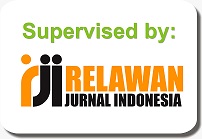ANALISIS ISI: DAMPAK STANDAR KECANTIKAN PADA FILM IMPERFECT: KARIER, CINTA & TIMBANGAN
Abstract
The purpose of this study is to find out the form, difference and how many beauty standard effects were shown up on Imperfect: Karier, Cinta & Timbangan movie. The form of beauty standard effects that shown up on the movie have a different frequencies in the whole movie. The population of this research is the whole scene of Imperfect: Karier, Cinta & Timbangan as many as 98 scenes. Coding between the coders based on coding book and coding guides that was made by the researcher. This research is using quantitative method and descriptive research. The data will use the one-way anova test for finding out the signification of the difference on beauty standard effects and table of frequency for finding out the form of beauty standard effects percentage on the whole scenes of the movie.
Keywords
Full Text:
PDF (Bahasa Indonesia)References
Afful, A. A., & Ricciardelli, R. (2015). Shaping the online fat acceptance movement: talking about body image. Journal of Gender Studies, 1-20.
Botta, R. A. (1999). Television Images and Adolescent Girls’ Body Image Disturbance. International Communication Association, 22-41.
Brown, A., & Knight, T. (2015). Shifts in media images of women appearance and social status from 1960 to 2010: A content analysis of beauty advertisements in two Australian Magazines. Journal of Aging Studies, 74-83.
Eisenthal, Y., Dror, G., & Ruppin, E. (2006). Facial Attractiveness: Beauty and the Machine. Neural Computation 18, 119-142.
Engeln-Maddox, R. (2006). Buying a Beauty Standard or Dreaming of A new Life? Expectations Associated with Media Ideals. Psychology of Women Quarterly, 258-266.
Katherine Frith, P. S. (2005). The Construction of Beauty: A Cross-Cultural Analysis of Women’s Magazine Advertising. Journal of Communication, 56-70.
Li, E. P., Min, H. J., & Belk, R. W. (2008). Skin Lightening and Beauty in Four Asian Cultures. Advances in Consumer Research (Volume 35), 444-449.
Morris, P. K. (2013). Conceptualizing Beauty: A Content Analysis of U.S. and French Women’s Fashion Magazine Advertisements. Journal of Communication and Media Technologies, 49-74.
Peggy Chin Evans, & Allen R. McConnell. (2003). Do Racial Minorities Respond in the Same Way to Mainstream Beauty Standards? Social Comparison Processes in Asian, Black, and White Women. Self and Identity, 153-167.
Prianti, D. (2013). Indonesian female beauty concept: Does it take into account the traditional values? . The Asian Conference on Media and Mass Communication, 1-12.
Silvestrini, M. (2019). “It’s not something I can shake”: The Efect of Racial Stereotypes, Beauty Standards, and Sexual Racism on Interracial Attraction. Sexuality & Culture.
Acharya, A. S. (2013). Sampling: Why and How of it? Indian Journal Of Medical Specialities, 330-333.
Riffe, D., Lacy, S., & Fico, F. (2014). Analyzing Media Message: Using Quantitative Content Analysis in Research. Newyork: Routledge
DOI: https://doi.org/10.32528/mdk.v5i1.7238
Copyright (c) 2022 MEDIAKOM

This work is licensed under a Creative Commons Attribution-NonCommercial-ShareAlike 4.0 International License.








